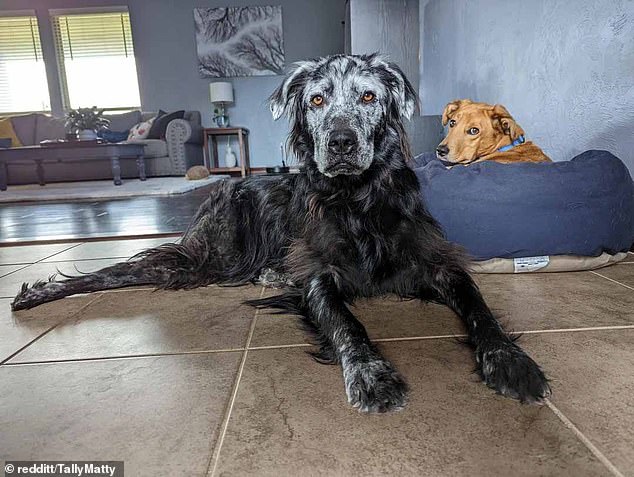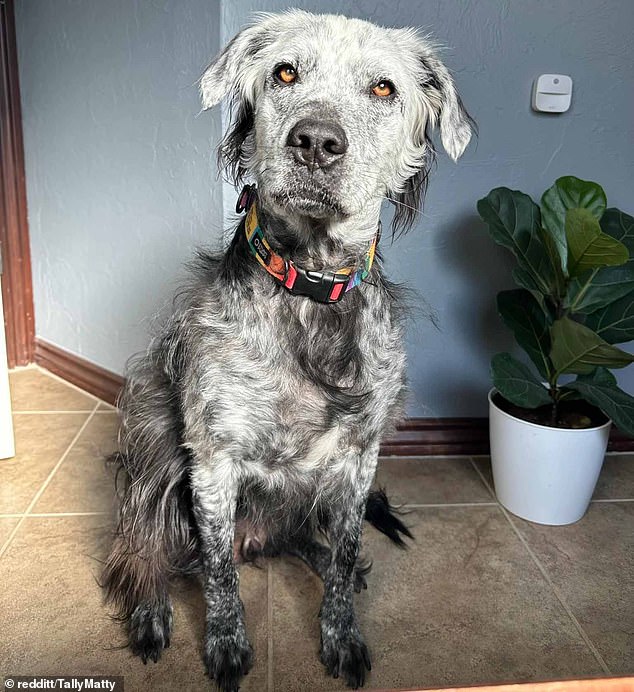Black dog turns completely WHITE 2.5 years after being diagnosed with vitiligo – as incredible photos detail his colour-changing transformation
Vitiligo – the condition that famously affected Michael Jackson – causes pale white patches to appear on human skin.
But as one dog owner can attest, the rare condition also affects animals.
Buster, an adorable four-year-old dog from Oklahoma, has turned from black to completely white due to his vitiligo.
Photos posted to Reddit show the pooch’s incredible color-changing transformation over the span of two and a half years.
Vitiligo is a condition in which the skin’s pigment cells are destroyed in certain parts of the body, but it affects the coat, hair and skin.

The amazing before and after photos were posted to Reddit by Buster’s owner, Matt Smith. His pet changed completely from black to white over the course of 2.5 years
It’s not clear why vitiligo occurs, but it is believed to happen when something interferes with cells that produce melanin, the substance that gives skin and hair its color.
Since the photos were posted to Reddit by Buster’s owner, Matt Smith (TallyMatty), based in Oklahoma City, the story has gone viral.
“My boy Buster (age 4) has completely changed from black to white in the last 2.5 years,” Matt said.
‘Buster has a skin condition called vitiligo – it causes depigmentation of the skin (and coat).’
Fellow Reddit users reacted with surprise, with many drawing comparisons to the world’s most famous vitiligo sufferer, Michael Jackson.
One posted: ‘Wow! This is the most fascinating thing I’ve seen on Reddit in a while.
“I was sure this was going to be fake until I scrolled through it.”
Another said: ‘If you hadn’t shown the transition I would never have believed it.
Yet another simply posted: “I’m barking at the dog in the mirror.”
The owner posted several photos dating back to the beginning of Buster’s amazing transformation.

The owner had noticed white spots near Buster’s mouth and chin before they started spreading across his face and body. Pictured, August 2022

A human or animal with vitiligo experiences depigmentation, which occurs when the skin loses its natural pigments. Pictured, November 2022

It’s not clear why vitiligo occurs, but it is believed to happen when something disrupts the body’s melanin-producing cells. Pictured, May 2023
He had initially noticed white spots near Buster’s mouth and chin before they started spreading across his face and body.
“He would lose his black fur and new white fur would come in,” Matt said.
“So there was a point where he went bald in places until his fresh, fluffy white coat grew back.”
Fortunately, vitiligo in pets is painless and the dog is not known to experience any suffering or discomfort.
It’s also quite rare; According to Rover.com, vitiligo occurs in less than one percent of dogs.
Some breeds – including Rottweiler, Old English Sheepdog, German Shepherd and Dachshund – are more sensitive than others.
In some dogs the entire body will be depigmented, but in others the condition will only appear in the form of spots or spots.
Vitiligo usually manifests at an early age, Rover.com adds, and almost always starts on the dog’s face.
According to PetMD, there are no available treatments for vitiligo that repigment a pet’s affected skin and coat.
“However, because vitiligo does not cause any discomfort, your dog or cat will be able to live well with this condition for the rest of his or her life,” it says.

August 2023: Buster is mostly white with any dark spots concentrated around his back and tail

October 2023: Vitiligo in pets is painless and the dog is not known to experience any suffering or discomfort
Many more owners have shared their experiences of having pets with vitiligo, including Elli, the adorable cookies-and-cream kitten from Germany.
Another Reddit user, u/BacardiBlue, said they once had a jet black cat that developed vitiligo.
“He started turning white on all his extremities… the tip of his nose, the tips of his ears, nose and tail, and then it spread further,” they said.
‘It was amazing to see the transformation over the seven years I had him, and my vet was absolutely fascinated.’
Meanwhile, Rowdy, the black Labrador, developed white spots around his eyes that look like they were painted on by their owners.
MailOnline has contacted Mr Smith and The Kennel Club for further clarification on Buster’s breed.
